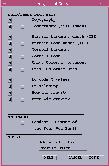

The grids and images occupy a significant part of the data sets within
the GEOID environment. Several of these data sets were collected as images.
Others were gridded for easier use. The cell size in each data set was
determined by either data point density or final disk space usage. All
the data sets in this category are projected. Projecting them on the fly
would take too long. The projection used is Equirectangular, which is also
the default projection in GEOID. The data sets can be accessed from the
main menu by pressing the "Images/Grids" button. The projection is set
to Equirectangular automatically; if it is set to some other projection
a warning message is displayed. Figure 33 shows the Images/Grids menu.
On top of the list is the topography data which include submarine bathymetry
as well. The cell size of this data set is 2 km. However, the 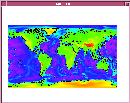
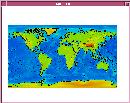 original
topography data had a resolution of 1 km. The bathymetry data came from
two different data sets, one with about 3 km cell size beneath most of
the oceans, and the other with 10 km cell size covering the polar regions.
We merged all these data sets and generated a 2 km cell sized data set,
hence subsampling the land areas and over sampling the bathymetry. Figure
34a shows of this data set. We also created a hill-shaded representation
of the topography. This representation allows the relief to be highlighted,
and it is convenient for display purposes. Figure
34b shows the shaded relief version of this data set.
original
topography data had a resolution of 1 km. The bathymetry data came from
two different data sets, one with about 3 km cell size beneath most of
the oceans, and the other with 10 km cell size covering the polar regions.
We merged all these data sets and generated a 2 km cell sized data set,
hence subsampling the land areas and over sampling the bathymetry. Figure
34a shows of this data set. We also created a hill-shaded representation
of the topography. This representation allows the relief to be highlighted,
and it is convenient for display purposes. Figure
34b shows the shaded relief version of this data set.
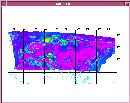 Eurasia
Basement Map
Eurasia
Basement Map
The Eurasia basement map covers, as its name implies, most of Eurasia.
It is from the former Soviet Unionís IPE (Institute for the Physics of
the Earth) maps. The data were gridded to a cell size of 10km. Figure
35 shows part of this data set in the Middle East and North Africa
region.
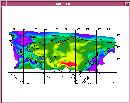 Eurasia
Moho Map
Eurasia
Moho Map
The Eurasia Moho map is similar to the Eurasia basement map in its source,
spatial extent and cell size. Both the basement and Moho maps can be used
for continental scale applications. Using them in regional and local studies
may be misleading due to their nature. They are averaged and simplified
and there is not an independent way of checking the quality of the reported
values. Figure 36
shows the Moho values in the Middle East and North Africa region.
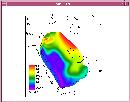 Cornell
basement
Cornell
basement
This data set was developed entirely at Cornell for the Middle East
region. Results from several published works as well as original work in
Syria were used in generating this data set. The refraction and gravity
profiles taken from the literature is shown in Figure 22a. Figure
37 shows the basement values and geographic extent of the data set.
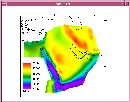 Cornell
Moho
Cornell
Moho
The Cornell Moho data set is also entirely developed at Cornell using several data sets including the profiles shown in Figure 22a, gravity maps, surface wave tomography results, and receiver function studies. Figure 38 shows the Moho values and the geographic extent of the data set. This is the most reliable Moho map in this region. The values can be confirmed with published data sets and other studies.
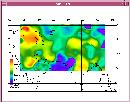 University
of Colorado Basement
University
of Colorado Basement
This data set was obtained from surface wave tomography studies by the University of Colorado group. The data set covers much of Asia including parts of the Middle East. Figure 39 shows this data set and its geographic extent.
 University
of Colorado Moho
University
of Colorado Moho
This is also a data set obtained from surface wave tomography by the
University of Colorado group. The data set also covers an area in Asia
with some Middle Eastern coverage. Figure
40 shows this data set.
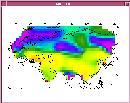 Lg
Coda Q values.
Lg
Coda Q values.
Lg coda Q values are obtained for Eurasia by the St. Louis University
research group. The values were obtained after a tomographic inversion.
Q values represent the efficiency of Lg wave propagation in the crust.
Figure 41 shows
the Lg coda Q values in the Middle East region.
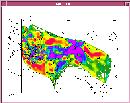 Pn
velocity
Pn
velocity
Seismic Pn phase velocities were obtained from the New Mexico State
University research group. The data set was obtained using a Pn tomography
technique in the Middle East region. The values represent variations from
a base velocity of 8.0 km/s. Figure
42 shows the data set and its geographic extent.
 Bouguer
gravity data of the Middle East and North Africa
Bouguer
gravity data of the Middle East and North Africa
These Bouguer gravity data were obtained by gridding the point data provided to us by the Defense Mapping Agency. We are not at liberty to disclose the locations that were used in gridding. However, a secondary data set is provided under the Metadata section to represent the variance of the grid provided. Figure 43 shows the Bouguer gravity map.
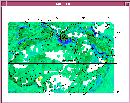 These Bouguer
gravity data were obtained by gridding the point data provided to us by
the Defense Mapping Agency. We are not at liberty to disclose the locations
that were used in gridding. However, a secondary data set is provided under
the Metadata section to represent the variance of the grid provided. Figure
43b shows the Bouguer gravity map.
These Bouguer
gravity data were obtained by gridding the point data provided to us by
the Defense Mapping Agency. We are not at liberty to disclose the locations
that were used in gridding. However, a secondary data set is provided under
the Metadata section to represent the variance of the grid provided. Figure
43b shows the Bouguer gravity map.
We currently hold a data set of about 100 TM scenes in the Middle East
and North Africa region. A selection of these scenes is now available in
GEOID. The Original TM scenes are about 30 m resolution. The data sets
in GEOID are subsampled versions of these data sets. The new cell size
is 285 m. The scenes were registered and a mosaic was formed. The scenes
cover two regions: one in the Atlas mountains of North Africa, and the
other in the Northern Arabian plate. Figure
44 shows the mosaic over the Middle East region. The other scenes are
being processed and registered.
Add a color bar
Add color bar tool is used with the grid to add a color bar for the
display images. The user can choose the location where the color
bar will be placed as well as the labeling parameters such as the increament
size, label values, and label color.
Some of the images shown above used this tool to add a color bar.
 The
Profile Maker
The
Profile Maker
 The
profile maker is a tool developed at Cornell to extract profiles or cross
sections from the gridded data sets. The profile maker can be used to extract
cell values along a transect, or it can be used to construct crustal scale
cross section including topography, basement, and Moho values. Clicking
on the "Profile Maker" button initiates a new sub menu and redraws the
screen. The screen is divided into two sections: one to plot the map and
the other to view the profile (or cross section) values. In the Profile
Maker menu first the grids need to be selected from the "Select the grids"
menu (Figure 45).
Then two points locations representing the beginning and end points of
the profile need to be entered. This can be done by either entering the
values in the text entry locations or by
The
profile maker is a tool developed at Cornell to extract profiles or cross
sections from the gridded data sets. The profile maker can be used to extract
cell values along a transect, or it can be used to construct crustal scale
cross section including topography, basement, and Moho values. Clicking
on the "Profile Maker" button initiates a new sub menu and redraws the
screen. The screen is divided into two sections: one to plot the map and
the other to view the profile (or cross section) values. In the Profile
Maker menu first the grids need to be selected from the "Select the grids"
menu (Figure 45).
Then two points locations representing the beginning and end points of
the profile need to be entered. This can be done by either entering the
values in the text entry locations or by 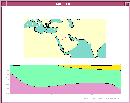 selecting
the "Select 2 points from the screen" button and marking two points on
the screen. Following this, pressing on the "apply" button would extract
the requested profile or cross section. Figure
46a shows a sample output of a cross section
selecting
the "Select 2 points from the screen" button and marking two points on
the screen. Following this, pressing on the "apply" button would extract
the requested profile or cross section. Figure
46a shows a sample output of a cross section  obtained
using the topography data across south America. A great circle path approximation
is applied between the points, so that the distance along the profile is
the minimal distance. The extracted profile can be saved in an ascii file
or plots of the map and the cross section can be made using the hardcopy
button. Another cross section involving topography, basement,
and Moho is shown in Figure
46b. Another example of Lg coda Q values (crustal) from England
to Iran is shown in Figure
46c.
obtained
using the topography data across south America. A great circle path approximation
is applied between the points, so that the distance along the profile is
the minimal distance. The extracted profile can be saved in an ascii file
or plots of the map and the cross section can be made using the hardcopy
button. Another cross section involving topography, basement,
and Moho is shown in Figure
46b. Another example of Lg coda Q values (crustal) from England
to Iran is shown in Figure
46c.